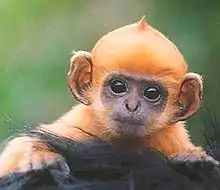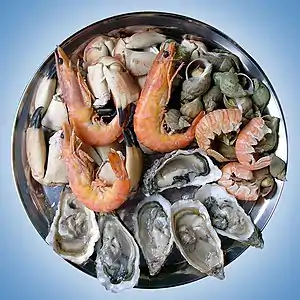Monkey meat
Monkey meat is the flesh and other edible parts derived from monkeys, a kind of bushmeat. Human consumption of monkey meat has been historically recorded in numerous parts of the world, including multiple Asian and African nations. Monkey meat consumption has been reported in parts of Europe and the Americas as well.[1]

By region
Liberia
A 2014 documentary by Vice News found that Liberia has a burgeoning monkey meat industry, with locals describing it as a "sweet" meat and expressing indifference to the risk of contracting the Ebola virus disease associated with monkey meat consumption in Africa.[2]
Republic of the Congo
The Congolese view monkey meat as an "ordinary delicacy" and a "must-eat", and is commonly served grilled, boiled, or fried; monkey carcasses are highly-valued, and are worth between 20,000 and 40,000 francs. A Nairobi News reporter covering the 2015 All Africa Games in Brazzaville observed that "residents scramble" for monkey meat, but are not as fond of the meats of other primates including baboon and chimpanzee.[3]
South Sudan
Consuming monkey meat is a defining feature of the Bari people, who "perceive the eating of monkey meat as a boundary between them and non-indigenous people"; in recent years, however, some Bari tribe members have shied away from the practice because of how similar monkeys look to humans.[4]
United States
A 2007 report by The New York Times documented several instances of monkey meat being secretly imported into the United States under the guise of other meats.[5] It is illegal to import bushmeat into the United States. Monkey meat found at the country's border entries will be seized and destroyed by border custom agents, along with any belongings that come with it.[6] People may be fined US$250,000 for importing monkey meat.[7]
Mexico
Spider monkey dishes are popular among natives from Southern Mexico. They are hunted yearlong despite being prohibited between March 1 and October 31.[8] In Los Tuxtlas, Veracruz, consumption of monkey meat was popular prior to the 2010s. As people began consuming more meat, monkey population in the region declined and monkey meat became less available.[9][10]
Cambodia
In October 2016, a raid was conducted on a market in Stung Treng, and resulted in the confiscation of two kilograms of dried monkey meat.[11]
China
Monkey meat has traditionally been viewed as a "prized (delicacy)" in Chinese cuisine, and is also believed to have medicinal qualities. In early 1934, the consumption of monkey meat alongside that of monkey brains was banned in Guangdong; an edict declared that "(m)onkeys possess many of the traits of man, and also considerable amount of intelligence, and should therefore be given protection."[12] The order was purportedly given by Chen Jitang.[13]
India
In April 2014, photographs of "hundreds" of monkey carcasses meant for consumption in Chhattisgarh went viral; despite the outcry by animal activists, however, government officials did little to address the issue, and even expressed scepticism at the photographs, as monkeys are sacred in most parts of India west of the Siliguri corridor.[14]
Indonesia
Indonesia is predominantly Muslim, and most Indonesians do not consume monkey meat. However, in Sulawesi, the Minahasan, a non-Muslim minority group, are known monkey eaters, and consider the crested black macaque a delicacy.[15][16]
Japan
Monkey meat has been historically seen as a delicacy in select areas of Japan including Hongū and Nagano, though current consumption is extremely rare at best. A Nagano proverb reads, "Don't feed your wife autumn monkey – to do so would be to waste a fine-tasting delicacy". A myriad of health benefits are said to be derived from the consumption of monkey meat, and, for instance, Japanese women allegedly consume monkey meat after childbirth to regain their vigour.[17]
Vietnam
In September 2015, a red-shanked douc was killed live at a Vietnamese eatery in Vu Quang. The carcass was reportedly sold for two million Vietnamese dong.[18]
Risks
The consumption of monkey meat may be detrimental to one's health. An August 1992 study published in the Journal of Tropical Medicine Hygiene reported nine cases of salmonellosis attributed to monkey meat consumption.[19]
In popular culture
In World War I, a French combat ration consisting of Argentine beef and carrots was dubbed "monkey meat" and is written to have been very salty in taste and poorly-received.[20] Virtually all variants of the American children's playground song "Great Green Gobs of Greasy, Grimy Gopher Guts" contain the lyrics "mutilated monkey meat".[21]
See also
References
- Hogenboom, Melissa (2014-10-19). "Is bushmeat behind Ebola outbreak?". BBC News. Retrieved 2018-09-16.
- "Monkey Meat and the Ebola Outbreak in Liberia". Vice News. June 26, 2014. Retrieved June 25, 2017.
- "City Where Monkey Meat Is The Most Cherished Delicacy". Nairobi News. September 16, 2015.
- Fuentes, Agustin; Wolfe, Linda (2002). Primates Face to Face: The Conservation Implications of Human-nonhuman Primate Interconnections. Cambridge University Press. p. 94. ISBN 9781139441476.
- Barry, Ellen (November 17, 2007). "A Taste of Baboon and Monkey Meat, and Maybe of Prison, Too". The New York Times.
- "Bringing Animal Products into the United States". Centers for Disease Control and Prevention. September 1, 2016.
- "Facts about Bushmeat and Ebola" (PDF). Centers for Disease Control and Prevention. September 2014.
- "Mono Araña" (in Spanish). Monterrey Institute of Technology and Higher Education. 2003.
- "Repoblarán la Isla de los Monos en Catemaco". Zócalo Saltillo (in Spanish). August 25, 2011.
- Castilla Arcos, Juan David (October 10, 2014). "En peligro, mono aullador y araña". El Heraldo de Veracruz (in Spanish).
- Kimsay, Buth (October 6, 2016). "Vendors Selling Porcupine, Monkey Meat Flee Arrest". Cambodia Daily.
- "Cat and Monkey Meat Is Taboo". The Calgary Daily Herald. March 17, 1934. p. 21.
- "China: Monkey Meat". Time. January 15, 1934.
- Drolial, Rashmi (April 12, 2014). "Illegal monkey meat trade rampant in Chhattisgarh". Times of India.
- "Jelang Natal, Permintaan Kuliner Ekstrim Khas Tomohon Meningkat [Demands for Macaca Nigra increases during Christmas – considered a delicacy]". Rima News. December 25, 2015. Archived from the original on December 25, 2015.
- "Indonesian market sells monkey meat, other exotic animals". Rappler. Retrieved June 23, 2017.
- Knight, John (2003). Waiting for Wolves in Japan: An Anthropological Study of People-wildlife Relations. Oxford University Press. p. 110. ISBN 9780199255184.
- "At an eatery selling endangered monkey meat in Vietnam". Tuoi Tre News. September 20, 2015.
- Lamabadusuriya, S. P; Perera, C; Devasiri, I. V; Jayantha, U. K; Chandrasiri, N (1992). "An outbreak of salmonellosis following consumption of monkey meat". Journal of Tropical Medicine Hygiene. 95 (4): 292–295. PMID 1495128.
- Pettyjohn, Wayne (2010). Slum and Guns: Tales of Marines In the Great War. Xlibris. p. 31. ISBN 9781456818098.
- "Booklet notes to the Smithsonian Folkways recording" (PDF). Archived from the original on February 21, 2014. Retrieved June 25, 2017.CS1 maint: bot: original URL status unknown (link)


